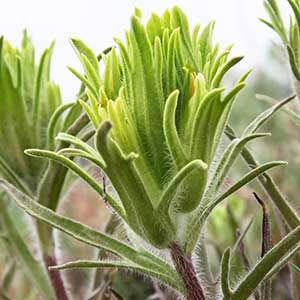Castilleja oresbia
Castilleja lacera
pale paintbrush, pale Wallowa Indian paintbrush, pale Wallowa paintbrush
cut-leaf owl's clover, cut-leaf paintbrush, cutleaf Indian paintbrush, foothill owl's clover
few to several, erect or ascending, sometimes decumbent at base, unbranched or branched, hairs usually retrorse, medium length, ± soft, eglandular, mixed with very short-glandular ones, sometimes with spreading, long, soft ones.
solitary, erect, unbranched or branched, hairs spreading, long, soft, scattered among more numerous, medium length, stipitate-glandular ones.
green to purple, linear to lanceolate, 2–7 cm, not fleshy, margins plane, involute, 3–5(–7)-lobed, apex acuminate to acute;
lobes spreading, linear to sometimes narrowly lanceolate, apex acute.
green or purplish, linear to narrowly lanceolate, 1–5 cm, not fleshy, margins plane, flat, 0–5(–7)-lobed, apex acuminate;
lobes spreading to ascending, linear, apex acuminate to acute.
2.5–18 × 1–3.5 cm;
bracts pale green to yellow-green or pale, dull reddish brown throughout, or proximally so colored but changing gradually to cream or yellowish on distal margins, narrowly to broadly lanceolate, (3–)5–7(–9)-lobed;
lobes ascending, linear, long, proximal lobes arising below mid length, central lobe apex obtuse, others acute.
(1.5–)3–14 × 2–3 cm;
bracts green throughout, sometimes proximally green, distally white on apices, lanceolate to ovate, 3–7-lobed;
lobes spreading to ascending, linear to narrowly lanceolate, long, arising below mid length, apex obtuse to acute.
straight, 21–36 mm;
tube 16–20 mm;
teeth of abaxial lip often exserted, beak exserted;
beak adaxially green, 4.2–5.5 mm;
abaxial lip green to purple, distally white, conspicuous, slightly but noticeably pouched, often visible through front cleft, 3–5 mm, 67–100% as long as beak, puberulent;
teeth erect, white, 1.8–2.1 mm.
straight, 10–22 mm;
tube 8–15 mm;
abaxial lip and beak exserted;
beak adaxially yellow to greenish, 3–6 mm, densely puberulent;
abaxial lip yellow with purple dots at base, inflated, pouches 3, central pouch slightly 2-lobed, pouches 4–8 mm wide, 3–6 mm deep, side pouches curving up a little at tip, 2–5 mm, 75–95% as long as beak;
teeth erect, white or yellow, 0.5–2 mm.
colored as bracts, 10–25 mm;
abaxial and adaxial clefts 6–7 mm, 30–60% of calyx length, deeper than laterals, lateral 5–10 mm, 40–50% of calyx length;
lobes linear, apex acute.
light green, lobes green, 7–13 mm;
abaxial and adaxial clefts 3.5–8 mm, 50–67% of calyx length, lateral 2.5–5 mm, ca. 40% of calyx length;
lobes narrowly to broadly lanceolate, apex acute to acuminate.
equal to or slightly exserted from beak.
= 22, 24.
Castilleja oresbia
Castilleja lacera
Castilleja oresbia is endemic to eastern Oregon and adjacent Idaho. It is easily confused with both varieties of C. pallescens, which also occur in sagebrush habitats. Castilleja oresbia has longer calyx lobes and softer pubescence than C. pallescens var. pallescens, although some transitional specimens are found. Castilleja oresbia has a combination of longer calyx lobes, longer pubescence, and obscurely nerved bracts, which usually serve to separate it from C. pallescens var. inverta. All three have different, though somewhat overlapping, ranges. Castilleja oresbia occasionally hybridizes with C. peckiana in Grant County, Oregon.
(Discussion copyrighted by Flora of North America; reprinted with permission.)
Castilleja lacera is found in a wide range of elevations in the central and northern Sierra Nevada region and in the Siskiyou Mountains region of northwestern California and southwestern Oregon. Reports from the Coast Ranges north of the San Francisco Bay region and south of the Siskiyou region in western California are referable to other yellow-flowered annuals, including C. ambigua, C. rubicundula var. lithospermoides, Triphysaria eriantha subsp. eriantha, and T. versicolor subsp. faucibarbata. Although most similar to C. rubicundula, C. lacera is somewhat smaller in stature and flower size. It is also easily confused with yellow-flowered populations of C. tenuis, which has smaller flowers and an included stigma. Two chromosome numbers are known for this species, the more northern populations being diploid, and those to the south having an apparently aneuploid count of 2n = 22, which is unique in the genus.
(Discussion copyrighted by Flora of North America; reprinted with permission.)


